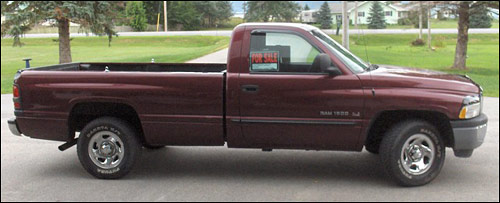 02-29-2008, 08:48 AM
02-29-2008, 08:48 AM
|
#2 (permalink)
|
|
Batman Junior
Join Date: Nov 2007
Location: 1000 Islands, Ontario, Canada
Posts: 22,541
Thanks: 4,085
Thanked 6,989 Times in 3,619 Posts
|
 The report examined a model like this 1995 Dodge Ram 1500 regular cab, with 8 foot bed
The report examined a model like this 1995 Dodge Ram 1500 regular cab, with 8 foot bed

One cap style tested. The light area between the cab and the cap is not a gap, it's material
applied to fair the cab to the bed cover. (Apologies for the poor image quality - it's a a
photgraph of a photcopy of a printout!)
The cover page of the report:
Quote:
Western New England College
1215 Wilbraham Road
Springfield, Massachusetts
School of Engineering
Senior Project
Spring 1997
Improving the Aerodynamic Characteristics of a Dodge Ram Pickup Truck
By: Todd J. Ortolani
Faculty Advisor: Dr. Alan K. Karplus
|
Excerpt from the Introduction (p.1) describing the objectives and in general the style of bed cap being investigated:
Quote:
The main objective of this Senior Design Project is to study the aerodynamic characteristics of a late-model Dodge Ram pickup truck, paying close attention to the rear bed, and to reduce the overall drag coefficient of the truck. This loss in drag will directly effect the rate of fuel consumption of the truck. Chrysler Corporation claims a baseline Cd of 0.4 for the Dodge Ram [Katz], a fairly high number by today's standards. A major implemented modification to reduce this number is a type of cap with an aerodynamically advantageous profile for the rear bed that closes off the large opening in front of the tailgate, increases the payload capacity in terms of covered volume, and, at the same time, maintains the functionality of the Ram as a pickup truck. My cooperating colleague, Vanwijak (Khem) Eowsakul has the responsibility in order to attain complete access to the bed cavity.
|
Excerpt from Construction of Test Apparatus (p.5) describing the wind & water tunnels used to gather data:
Quote:
|
The aerodynamic characteristics of a Dodge Ram pickup truck were analyzed by utilizing the Western New England College wind and water tunnel facilities in conjunction with [1/18th and 1/25th] scale models of this vehicle. The water tunnel allows for visualization of the flow as it reaches and flows over the pickup truck. Points of separation and turbulence were to be recognized. The wind tunnel allows for a resultant drag force on the Ram to be obtained, which is entered into equation (1) to calculate the drag coefficient (Cd).
|
Note:
The WNEC professor who forwarded the report to me, Dr. Said Dini (currently a Professor of Mechanical Engineering who is acknowledged in the report as having assisted the project), offered this disclaimer: "I am not certain of the accuracy of the results."
The student author also discussed some of the factors which may have affected his calculations/conclusions. I'll get to them as well.
More to come...
|
|
|

|